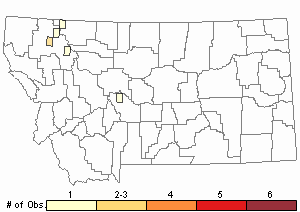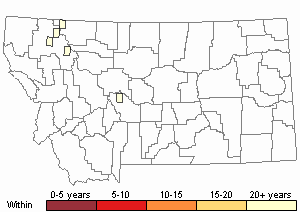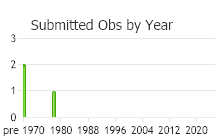View in other NatureServe Network Field Guides
NatureServe
Montana
Utah
Wyoming
Idaho
Wisconsin
British Columbia
South Carolina
Yukon
California
New York
A Limestone Moss - Seligeria campylopoda
General Description
Plants: Acrocarpous, minute, olivaceous. Stems seldom 2- or 3-forked (FNA 2007), about 1 mm tall (Lawton 1971), sometimes to 2 mm (Crum and Anderson et al. 1981).
Leaves: Rigidly upright to spreading and a little twisted when dry, usually spreading to about 45 degrees or more with the distal end curved back and downward when damp (FNA 2007), 0.6-0.8 mm in length (Lawton 1971), lance- to strap-shaped, steadily tapering to an obtuse (or nearly so) leaf tip; leaf edges flat, smooth (FNA 2007) or faintly saw-toothed at the apex (Lawton 1971); costa subpercurrent, not occupying the entire apex (FNA 2007).
Leaf Cells: Laminal cells with length 1-2 times that of the width (FNA 2007), oblong and very thin near the attachment (Crum and Anderson et al. 1981).
Diagnostic Characteristics
Identifying members of Seligeriaceae to species requires sporophytes (FNA 2007).
Range Comments
North American Range
AK and YT to WA, AB and MT, ON to NB and NL, CO, SD, IA, MN to MI, NY and PA (FNA 2007). Known in Montana from Flathead, Glacier, Meagher, and Ravalli Counties (Elliott and Pipp 2016).
Observations in Montana Natural Heritage Program Database
Number of Observations: 7
(Click on the following maps and charts to see full sized version)
Map Help and Descriptions
Relative Density

Recency


 (Observations spanning multiple months or years are excluded from time charts)
(Observations spanning multiple months or years are excluded from time charts)
Habitat
Moist stones (Lawton 1971), typically on rock bluffs and boulders, but occasionally on small, moist or dry, shaded rocks; calciphilic (Crum and Anderson et al. 1981).
Reproductive Characteristics
Autoicous. Perichaetial bracts akin to stem leaves except bigger. Seta a little bent and twisted, substantially bowed above when dry, 1.6-3 mm tall (FNA 2007), yellow. Capsule a little longer than wide (Crum and Anderson et al. 1981); peristome single, with 16 teeth, smooth (FNA 2007), unlobed, russet (Lawton 1971). Calyptra draping like a hood (FNA 2007).
References
- Literature Cited AboveLegend:
 View Online Publication
View Online Publication Crum, H.A. and L.E. Anderson. 1981. Mosses of Eastern North America. 2 volumes. Columbia University Press, New York. 1328 pp.
Crum, H.A. and L.E. Anderson. 1981. Mosses of Eastern North America. 2 volumes. Columbia University Press, New York. 1328 pp. Elliott, J.C. and A.K. Pipp. 2018. A Checklist of Montana Mosses (1880-2018). Updated 3 January, 2020. Montana Natural Heritage Program, Helena, Montana. 73 pp.
Elliott, J.C. and A.K. Pipp. 2018. A Checklist of Montana Mosses (1880-2018). Updated 3 January, 2020. Montana Natural Heritage Program, Helena, Montana. 73 pp. Flora of North America Editorial Committee, eds. 2007. Flora of North America North of Mexico. Volume 27. Bryophytes: Mosses, Part 1. Oxford University Press, Inc., NY. xxi + 713 pp.
Flora of North America Editorial Committee, eds. 2007. Flora of North America North of Mexico. Volume 27. Bryophytes: Mosses, Part 1. Oxford University Press, Inc., NY. xxi + 713 pp. Lawton, E. 1971. Moss Flora of the Pacific Northwest. Hattori Botanical Laboratory. Japan: Yamabuki-cho, Shinjuku-ku, Tokyo. 362 pages plus appendices.
Lawton, E. 1971. Moss Flora of the Pacific Northwest. Hattori Botanical Laboratory. Japan: Yamabuki-cho, Shinjuku-ku, Tokyo. 362 pages plus appendices.
- Additional ReferencesLegend:
 View Online Publication
View Online Publication
Do you know of a citation we're missing? Elliot, J. C. 1993. Second checklist of Montana mosses. Unpublished report. U.S. Forest Service, Region 1. Missoula, MT. 45 pp.
Elliot, J. C. 1993. Second checklist of Montana mosses. Unpublished report. U.S. Forest Service, Region 1. Missoula, MT. 45 pp. Flowers, S. 1973. Mosses: Utah and the West. Brigham Young University, Provo, Utah. 567 p.
Flowers, S. 1973. Mosses: Utah and the West. Brigham Young University, Provo, Utah. 567 p. Lawton, E. 1971. Keys for the Identification of the Mosses on the Pacific Northwest. Reprinted from 'Moss Flora of the Pacific Northwest'. Published as Supplement No. 2 of the Journal of the Hattori Botanical Laboratory. Nichinan, Miyazaki, Japan. 66 pp.
Lawton, E. 1971. Keys for the Identification of the Mosses on the Pacific Northwest. Reprinted from 'Moss Flora of the Pacific Northwest'. Published as Supplement No. 2 of the Journal of the Hattori Botanical Laboratory. Nichinan, Miyazaki, Japan. 66 pp. Vitt, D. J. Marsh, and R. Bovey. 1988. Mosses, Lichens & Ferns of Northwest North America. Seattle, WA: University of Washington Press. 296 p.
Vitt, D. J. Marsh, and R. Bovey. 1988. Mosses, Lichens & Ferns of Northwest North America. Seattle, WA: University of Washington Press. 296 p.
- Web Search Engines for Articles on "A Limestone Moss"





